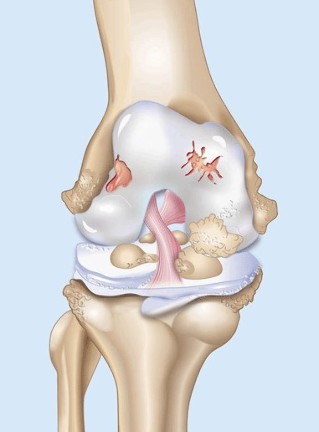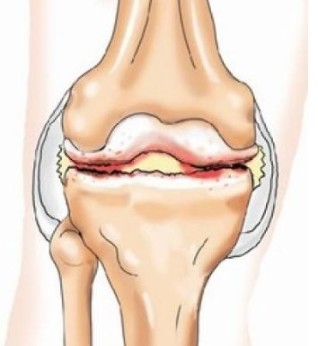Deforming gonarthrosis (arthrosis of the knee joint) is a disease of hyaline articular cartilage creates knee cartilage, due to the inflammatory degenerative-dystrophic process. This disease includes tibial condyle and thighs.
Osteoarthritis of the knee-joint develops slowly. Primary symptoms of this disease are pain and stiffness of the movements. This type of arthritis, such as osteoarthritis of the knee, is most common in comparison with other types (arthrosis of phalanges of the fingers, hip osteoarthritis, elbow or shoulder joint arthritis).
This is the disease manifests itself most often in people of middle age (40-45 years), predominantly in women. The reason for the development of osteoarthritis in young people can serve to any serious injury, or a heavy load (e.g. in athletes).

The causes of osteoarthritis of the knee
The cause of deforming arthrosis of the joints can not be alone, in General, the totality of the circumstances, and many catalytic factors, which lead over time to the development of the disease. In medicine, the causes of osteoarthritis are as follows divided:
- primary;
- secondary.
Primary osteoarthritis develops in older people due to the natural aging process (delete) the cartilaginous tissues of the body in connection with the accompanying complications. In the number of complications and problems such as:
- hereditary pathology;
- increased load on the joints in the course of life;
- Obesity (in 10% of cases).
To include the secondary deformavit osteoarthritis 30% of all cases of the disease in the knee iuncturam. This Form of osteoarthritis develops as a result of the various traumas:
- Damage to the meniscus;
- Fracture of the Tibia;
- Torn ligaments;
- strong contusion and pain in the kneecap.
Symptoms and signs of secondary osteoarthritis manifests itself very late – after 3-4 years, however, severe violations of the signs of the disease 3-4 months found.
In the group of risk of development of osteoarthritis of the knee people, the start to 40 years of age, to actively participate in sports or other physical activities. Run, squats, or pushups additional work give worn-out age, the joints. Such activities lead to a rapid development of the degenerative and degenerative processes in the joints.
Frequent cases of osteoarthritis on the bottom of the existing comorbidities of the patient:
- Ankylosing Spondylitis;
- rheumatoid, psoriatic or reactive arthritis;
- Gout;
- Varicose veins;
- overweight (obesity).
Among the causes of the development of deforming arthrosis directly into the knee joint:
- regular heavy physical load;
- Weight lifting;
- frequent ascents to the stairs;
- professional sports;
The risk of such a diagnosis, such as osteoarthritis of the knee, increases, if the Patient's injuries were found vertebral body Department of bone, a variety of neurological disorders, metabolic disorders, Diabetes mellitus, and (3-5%) of the cases, a genetic Disposition, due to the weakness of the ligamentous apparatus.
Often (50-60%) the development of osteoarthritis of the knee is due to muscle of the front of the thigh cramps. Such a seizure does not occur up to the time of occurrence of pain in the knees. Disadvantages are the weak pain in the lower back, heavy legs, and fatigue.
If the iliopsoas and Rectus femoris are constantly in a state of spasm, to develop with the age of the patient "shrinkage" of the knee, the motor function significantly restrict.
Scientists latest discovery
The Belgian surgeons and orthopaedic surgeons in the city of Leuven recently discovered a previously unknown and absolutely not studied bundle ALL localized in the human knee. This bundle was lateral to the name of "anterior" or "anterior laterala".
Studies, the joints longer since the age of 4 rare cases where patients after the implementation of a successful surgery due to the fractures of the ligaments or injury to the knee, pain under physical strain has not disappeared, and there was instability in the knee have been confirmed.
To the research, around 40 patients, what is allowed, were involved in this realize the bundle that was not at the doctors of data in General. As it turned out, the main function is Antero laterala bands rotational movements of the tibial bone.
In the case of negligent injury to the knee doctor, and also no idea about the need for correction during the Operation.
The classification of osteoarthritis of the knee
The disease often develops only in a knee joint. Given the intensity of the development of pathological processes, the doctors you have 3 degrees of osteoarthritis of the knee:
- The first degrees of knee osteoarthritis leads deformavit changes, however, the characteristic periodic pain after the loading of the joint. Occasionally a slight swelling of the joint is shown, it disappears itself.
- In the case of osteoarthritis of the knee joint in the second degree signs and symptoms of the disease significantly more difficult. Pain syndrome is manifested already after a little physical exertion. Hiking, weight lifting can cause sensations of lengthy and intense pain, gnashing of the Patient a characteristic knee. Probably a slight deformation of the joint and a small restriction of movement occur.
- In the third degree of deforming arthrosis of the knee joint articulation, the maximum disclosure of the symptoms of the disease observed. The Patient disturbed gait, pronounced deformity of the joint and severe functional limitations movements. The pain sensations are amplified, depending on the weather, the limitations of the joint up to a maximum point. The pain is so severe that the Patient is not able to find the Position in which you fell, sleep disorders.

What confusion osteoarthritis of the knee-joints?
There are several related conditions about your symptoms with knee osteoarthritis:
The Blockade and the Blockade of the knee joint meniscus. This disease develops rapidly. In the case of the violent movement of the crunch in the knee occurs accompanied by an attack of acute pain by 10-15 minutes. A day later, the swelling of the knee occurs.
Different types of Arthritis (rheumatoid, psoriatic, reactive), rheumatoid arthritis, ankylosing spondylitis, gout. To distinguish this disease from osteoarthritis can test with the help of blood.
Inflammation of the tendons of the knee. Such disease mainly affects women after the age of 40. Pain occurs when lifting or the descent of the stairs. The pain covers the inner surface of the knee, but the functionality of the joint is not restricted.
Vascular pain in the knee joints. This symmetrical lesion of the joints, both knees at the same time. It occurs mainly in the young Generation because of the accelerated bone growth. Pain syndrome celebrated:
- when there is a change in the weather;
- in the case of colds;
- in the case of the physical stress.
Defined as an aching pain (wrestling).
Signs and symptoms deformed knee osteoarthritis on the stage
In the first stage, the affected knee joint according to external characteristics is not different from that of healthy people.
- Sometimes in the area of the lesion, you may notice a slight swelling.
- In rare cases, iuncturam the accumulation of fluid observed, and it is highly welded, the assumption of a spherical shape.
- A Synovitis develops.
- The functionality of the joint is limited.
- To present a feeling of heaviness.
What is it?
In the initial phase of the development of osteoarthritis in the joint, it comes to disorders of the small inner-bones-blood vessels and blood circulation overall, it is depends on the nutrition of cartilage damage.
In the further development of the disease (the second stage) symptoms increased. The pain is in the front inner side of the articulation, and also disturbs not in the case of larger loads, retreat in peace and again at the slightest movement.
When deforming arthrosis of the joint of the third degree, a significant deformation of the bones articular cartilage is observed. They are intertwined, pressed, and abgeschertes cartilage tissue is almost destroyed, functional limitations increased. Pain syndrome exercises for a Minute, regardless of the voltage or the state of rest, in which the joint. Flexion and extension of the limb is difficult.
Joint is severely deformed, the legs bent in the O - or X - shaped, the gait becomes unstable. Often, the Patient will move with the help of crutches or sticks.

































